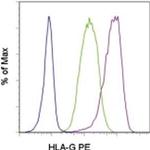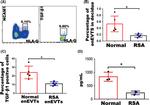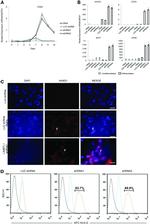Search Thermo Fisher Scientific
Invitrogen
HLA-G Monoclonal Antibody (87G), PE, eBioscience™
FIGURE: 1 / 4
HLA-G Antibody (12-9957-42) in Flow




Product Details
12-9957-42
Species Reactivity
Published species
Host/Isotype
Recommended Isotype Control
Class
Type
Clone
Conjugate
Excitation/Emission Max
Form
Concentration
Purification
Storage buffer
Contains
Storage conditions
Shipping conditions
RRID
Product Specific Information
Description: The monoclonal antibody 87G recognizes human HLA-G, a member of the Human Leukocyte Antigen family but as part of the nonclassical MHC type involved in inhibiting immune reponses. HLA-G has seven reported isoforms. The antibody 87G recognizes both HLA-G1 and the solube HLA-G5. Expression of HLA-G is found primarily in fetal trophoblast cells as they invade the maternal decidua thereby protecting the fetus from the maternal immune system. Like the highly mitotic trophoblast, abundant HLA-G protein expression has been identified in some tumors, including melanoma, breast carcinoma and renal carcinoma as well as CLL, AML and B-CLL. Some expression has also been found in pancreatic islets, erythroid and endothelial progenitors and the adult thymic medulla.HLA-G+ CD4 or CD8 cells have been identified in normal human peripheral blood and are thought to act as regulatory cells in that they are hypoproliferative with a unique cytokine profile differing from Tregs. The receptors for HLA-G are CD85j/ILT2, CD85d/ILT4, and CD158. Recent studies have shown a role for HLA-G in tolerance and maintenance of transplanted organs.
Applications Reported: This 87G antibody has been reported for use in flow cytometric analysis.
Applications Tested: This 87G antibody has been pre-titrated and tested by flow cytometric analysis of stimulated U937 cells. This can be used at 5 µL (0.25 µg) per test. A test is defined as the amount (µg) of antibody that will stain a cell sample in a final volume of 100 µL. Cell number should be determined empirically but can range from 10^5 to 10^8 cells/test.
Excitation: 488-561 nm; Emission: 578 nm; Laser: Blue Laser, Green Laser, Yellow-Green Laser.
Filtration: 0.2 µm post-manufacturing filtered.
Target Information
HLA-G belongs to the HLA class I heavy chain paralogues. This class I molecule is a heterodimer consisting of a heavy chain and a light chain (beta-2 microglobulin). The heavy chain is anchored in the membrane. HLA-G is expressed on fetal derived placental cells. The heavy chain is approximately 45 kDa and its gene contains 8 exons. Exon one encodes the leader peptide, exons 2 and 3 encode the alpha1 and alpha2 domain, which both bind the peptide, exon 4 encodes the alpha3 domain, exon 5 encodes the transmembrane region, and exon 6 encodes the cytoplasmic tail.
HLA and MHC antibodies play a significant role in Immunopeptidomics, facilitating the identification and characterization of neoantigens through high-performance liquid chromatography coupled to tandem Mass Spectrometry.
For Research Use Only. Not for use in diagnostic procedures. Not for resale without express authorization.
How to use the Panel Builder
Watch the video to learn how to use the Invitrogen Flow Cytometry Panel Builder to build your next flow cytometry panel in 5 easy steps.
Bioinformatics
Protein Aliases: b2 microglobulin; DADB-15K14.8; HLA class I histocompatibility antigen, alpha chain G; HLA class I molecule; HLA G antigen; HLA-G histocompatibility antigen, class I, G; MHC class I antigen G
Gene Aliases: HLA-6.0; HLA-G; HLAG; MHC-G
UniProt ID: (Human) P17693
Entrez Gene ID: (Human) 3135

Performance Guarantee
If an Invitrogen™ antibody doesn't perform as described on our website or datasheet,we'll replace the product at no cost to you, or provide you with a credit for a future purchase.*
Learn more
We're here to help
Get expert recommendations for common problems or connect directly with an on staff expert for technical assistance related to applications, equipment and general product use.
Contact tech support

